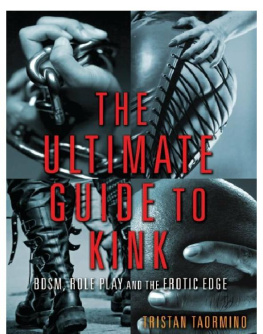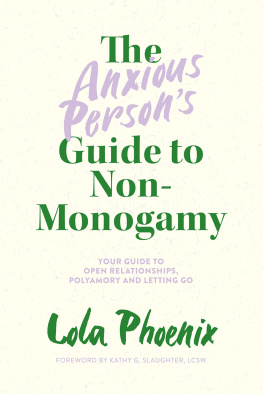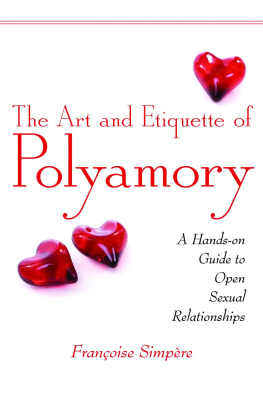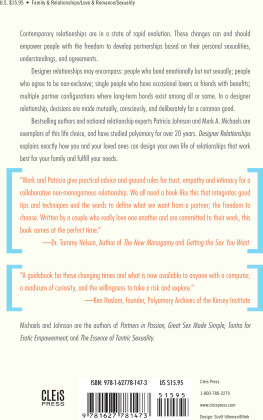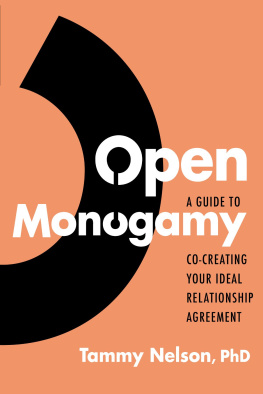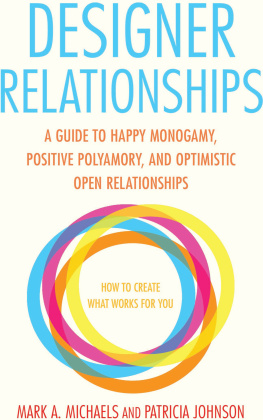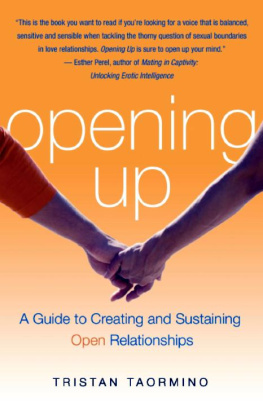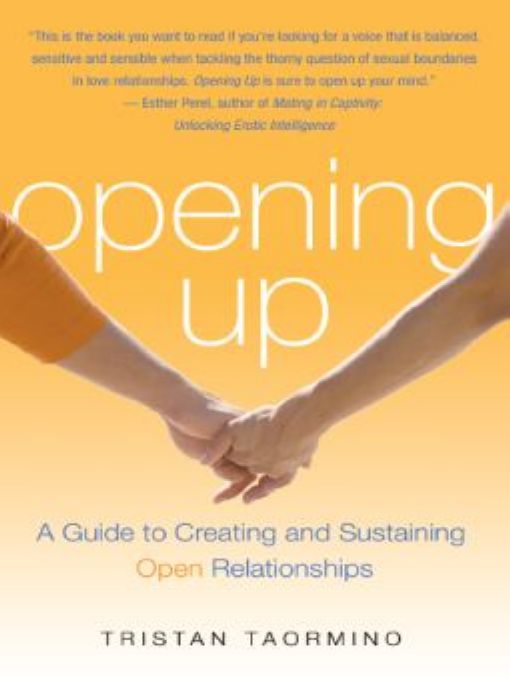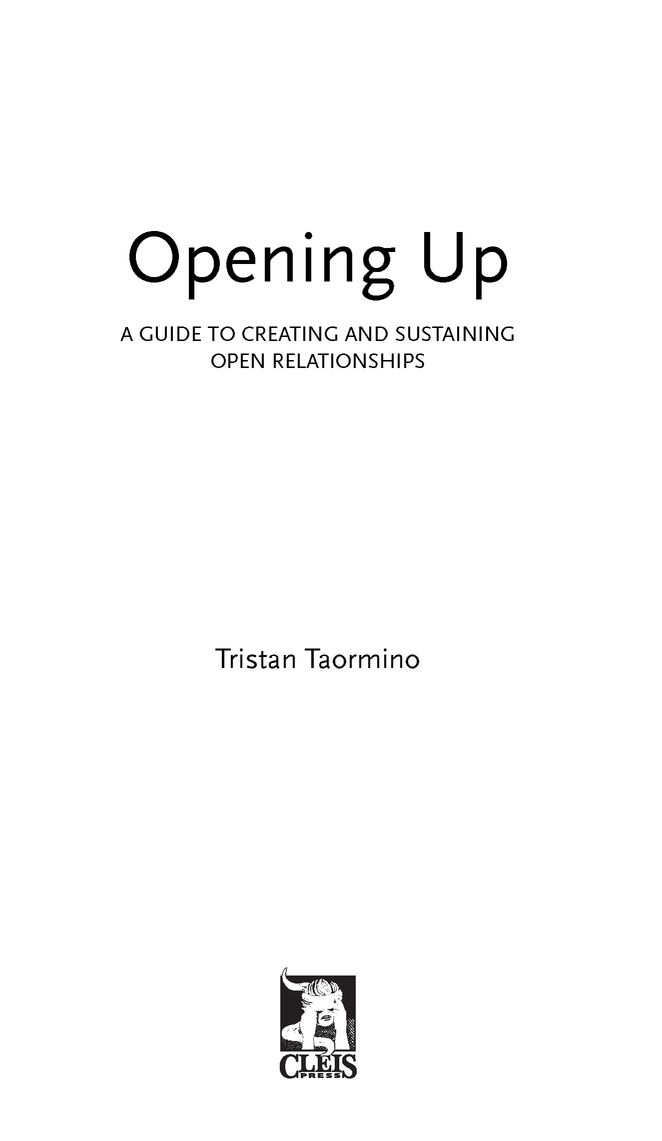Table of Contents
I dedicate this book to every person who has the courage to live and love outside the box
Acknowledgments
I MUST ACKNOWLEDGE some of the pioneers in this field whose work has made it possible for mine to exist: Deborah Anapol, Joan and Larry Constantine, Dossie Easton and Janet Hardy, Raven Kaldera, Ronald Mazur, and Ryam Nearing. I had my first light-bulb moment about this topic at dinner with two friends after a panel discussion by Jill Carter, Queen Cougar, and Vi Johnsonthey all unknowingly played a part in the early germination of the idea. Throughout the years, I have learned a great deal from classes about polyamory taught by Jon and Carin, Dossie Easton, Sarah Sloane, Anita Wagner, and Lolita Wolf. Several years ago, I worked jointly on a book proposal on this topic with Dr. Winston Wilde, and although we ended up not collaborating on the project, I am forever grateful to him for his knowledge, experience, mentoring, and love.
I would like to thank Jennifer Ferris of Kelsey Transcripts, Helen Boyd, and Emily Salzfass for their transcription work. Helen Boyd also provided invaluable research assistance. Tey Meadows assisted me in finding transcription help, located important legal articles, and sparked inspiration in me when it was greatly needed. Valerie White of the Sexual Freedom Legal Defense and Education Fund was generous with her time and wisdom. Mark Michaels and Patricia Johnson had a huge influence on this work; they shared rare books from their collection, discussed their experiences as Tantra and relationship coaches, and had innumerable conversations that helped me conceptualize key sections. Anita Wagner was an integral part of this book: she spread the word far and wide, distributed interviews, shared her insight, and on top of all that, single-handedly compiled the majority of the Resource Guide. Members of several LiveJournal communities helped get the word out as I searched for interviewees. The incredible people who make up the Dark Odyssey community inspire and teach me year after year.
My agent, Andrew Blauner, helped kick-start this project after it had been shelved and gathering dust. He is my cheerleader, my gentle reminder, my advocate, and my friend. Thanks to everyone at Cleis Press for their support. My publishers, Felice Newman and Frdrique Delacoste, accepted delays with grace and continue to be a joy to work with; Felice edited the manuscript herself and, as always, provided thoughtful, invaluable editorial advice.
My friends mean so much to me and have cheered me on in this project. Thanks to Arielle, Barb ONeill and Dylan Bosseau, Clyde, Helen Boyd and Betty Crow, David Aguilar, Ira Levine and Nina Hartley, Kate Larkin and Johann vanOverbeek, Mark Michaels and Patricia Johnston, Mary DiStefano and Dana Wegener, Tey Meadows, Toni Amato and Opn. Thanks to my mother, who continues to support me unconditionally.
Many writers partners feel widowed when the writer starts a new book. My partner, Colten Tognazzini, is no different and yet he was an unbelievable support to me. I literally could not have researched and written this book without him. He organized responses from my LiveJournal posting for interviewees; he rewired the phone line, set up the microphone, and figured out the software so I could record all my interviews on my laptop; he fed me so I could keep writing; he edited the bibliography; he allowed me the time and space to dive headfirst into the project and let it consume me; he listened while I bounced around ideas; he picked up the slack and ran our businesses so I could concentrate on the book; he made me take short breaks so I wouldnt go insane; he let me work until my brain was fried and my eyesight blurry, then he gently told me to put the computer down.
And finally, my undying gratitude goes to all the people I interviewed. They took time out of their busy lives to answer my written interview questions, and some took even more time to talk to me on the phone or in person. They were truly excited about the book and willing to talk about nearly anything and everything. Their candor and courage is amazing; what they said and how they said it was invaluable. I learned so much from every single one of them. Their words, their voices, their struggles, their opinions, their successes, and their challenges make this book what it is.
Introduction
Opening Up to the Possibilities: Challenging Monogamy and Revolutionizing Relationships
MY LIFES WORK for more than a decade has been dedicated to educating and empowering people around their sexuality. I write about sex, I teach workshops and lecture about sex, I answer peoples questions about sex, I demonstrate techniques for sex, I make sex-positive movies, and I produce sex events. Because of my work and my never-ending interest in all things sexual, I have witnessed and indulged in a wide variety of sexual experiences and met people from all walks of life. Ive met people who are straight, queer, bi, vanilla, kinky, and just plain horny. Ive made friends with leatherfolk, swingers, gender-queers, sex workers, polyamorous people, Tantra practitioners, Pagans, and sex radicals.
The first time I saw someone have sex right in front of me, I was mesmerized, awestruck, turned on. It was really cool. The 400th time, its still cool, but its different. I found myself less interested in the surface of what I was seeinghow he licks her, the noises she makes when she fucks her, the way he looks when she plays with his ass, what he says when he talks dirty to him, and on and on. Instead, I was much more fascinated by who the people are. Are they a couple? How long have they been together? What made them decide to come to this sex event? What do they like about having public sex? Who is that other woman I often see making out with them both? Do they have sex with other people? I want to know what the context is for what I am watching. I want to know about the inner workings of their relationship.
And it was no wonder. As I got to know these people, I discovered that their relationships were a lot more intriguing, complex, and transgressive than their sex lives (and their sex lives were pretty amazing). In addition to sharp communication skills and a creative sense of identity, they all appeared to have one thing in common: they were all in nonmonogamous relationships. And theyd found a way to make those relationships work so well that they exuded an above-average level of sexual and emotional satisfactionsomething that in my experience and observation seems to elude a lot of people. So, I wondered, just how do they do it?
The Decline of Marriage and Monogamy
Most of the worlds peoples, throughout history and around the globe, have arranged things so that marriage and sexual exclusivity are not the same thing.The Myth of Monogamy
Its no secret that traditional monogamous marriage in America is in serious trouble and has been for quite a while. The model of the stay-at-home wife and the husband as sole breadwinner began to change during the Industrial Revolution; it shifted significantly when women entered the workforce in record numbers during World War II. Once women began working outside the home, earning their own money (albeit less money for the same work), exploring education and career opportunities, gender roles shifted and marriage changed. In the 1950s there was a brief return to more traditional coupling: 96 percent of people of childbearing age were married, and they got married at a younger age.


